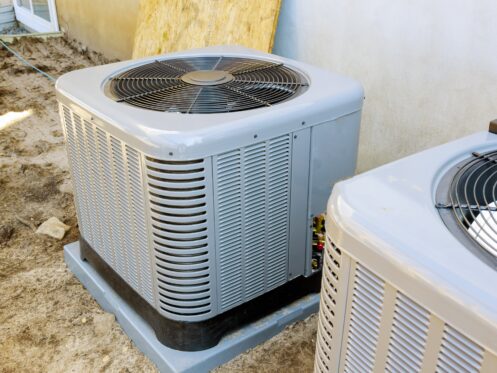Denver, CO, is located on the High Plains near the east front of the Rocky Mountains, making it an outdoor explorer’s dream. Knowing how to get the most energy efficiency from your HVAC system is important if you’re a homeowner in the greater Denver metro area. One of the key elements to efficient operation is knowing what the SEER rating in HVAC is and what it means. The experts at High 5 Plumbing, Heating, Cooling, and Electric are available to help you understand these ratings and choose the best system for your unique needs.
Understanding SEER Ratings
The term SEER stands for Seasonal Energy Efficiency Ratio, which is determined when the cooling output of an HVAC system over an average cooling season is divided by the total energy used. In other words, the SEER rating shows how much energy and money the system needs to operate over a single year. The SEER of an HVAC system is determined for one full cooling season, and the less energy the system uses to cool the home, the higher the SEER rating it receives.
Most HVAC systems built between 10 and 15 years ago typically have a SEER rating between eight and 10, but newer and more modern systems have higher ratings. Here’s how to find the SEER rating for your unit:
- Look for the yellow and black EnergyGuide sticker, which is usually located somewhere prominently on the outdoor unit.
- There may be a piece of paper attached to the indoor unit (air handler) of your HVAC system which will indicate the SEER rating.
- If you can’t find either of these items, the model number of the unit should reference the SEER rating. For example, if your HVAC’s model number is “XZ10,” it represents up to 10 SEER.
Factors Influencing SEER Ratings
The higher the SEER rating, the more efficient your system operates. However, some key factors may influence an HVAC SEER rating.
Climate
Areas that experience extreme temperatures often require homeowners’ HVAC systems to work harder. When your HVAC system works harder, it can lower the SEER rating because it requires more energy to operate efficiently and keep your home at a comfortable temperature over one cooling period.
Insulation
Homes that are well insulated are protected from heating and cooling loss. The right insulation in your attic and around doors and windows can help you benefit from a high SEER system since your home will stay more comfortable.
HVAC system size
If your HVAC system is too large or too small related to the size of your home, it may result in inefficient operation. When the system has to struggle and starts to run inefficiently, it lowers the SEER rating.
Usage
If you’re using your AC too frequently during the summer, it can make HVAC systems with a high SEER rating less efficient. This is particularly important in terms of long-term savings over the system’s entire lifespan.
Benefits of High SEER Ratings
A system with a high SEER rating in your Denver-area home has many benefits:
- High SEER ratings translate to higher energy efficiency, ultimately leading to greater savings on your monthly utility bills.
- Systems with a high SEER rating provide greater comfort by keeping your desired indoor temperature steady, even during extreme outdoor temperature changes.
- Not only is a high SEER rating good for energy efficiency and comfort, but it’s also a great way to lower your environmental impact. New models use safer refrigerants that contribute to a cleaner, greener environment for future generations.
How SEER Ratings Impact Energy Bills
Replacing an older system with a newer one with a higher SEER rating should help you save significant money on your household energy costs each year. According to the U.S. Department of Energy, many newer HVAC systems have a SEER rating as high as 26, and all of them must be at least 13 or higher in the northern states.
When you combine a new HVAC system with a higher SEER rating with improved home insulation and clean ductwork that’s free of cracks or damage, you should notice quite a significant improvement. Remember, higher SEER ratings equal better energy efficiency, which should translate to savings on your monthly energy costs.
Choosing the Right SEER Rating for Your Needs
Most new HVAC systems fall within a SEER rating range of 13 to 21, while some may go up to between 22 and 26. A unit with a SEER rating of 13 or 14 should be sufficient for an average-sized home. However, if your home is large, multi-level, or you have quite a lot of square footage to cover, a SEER rating higher than 14 is ideal.
Other factors like the cleanliness and condition of your ductwork, your local climate, and how well your home is insulated also play a role. If you have good insulation and your ductwork is in great shape, the standard SEER rating of 13 or higher should suffice. In most cases, manufacturers of HVAC systems use the SEER rating to show consumers the maximum level of energy efficiency the system can achieve. If you want peace of mind knowing your new system is as energy efficient as possible, choose one with the highest SEER rating available that fits your budget.
Contact the Team at High 5 To Learn More About Seer Ratings and New AC Unit Installation
The team at High 5 Plumbing, Heating, Cooling, and Electric is a leading contractor in Denver, Littleton, Golden, and the surrounding areas. If you want to learn more about SEER ratings and a new AC unit installation, we’re happy to help. Contact us today for more information about these ratings or if you’d like to schedule maintenance, service, or an estimate for a new installation.

